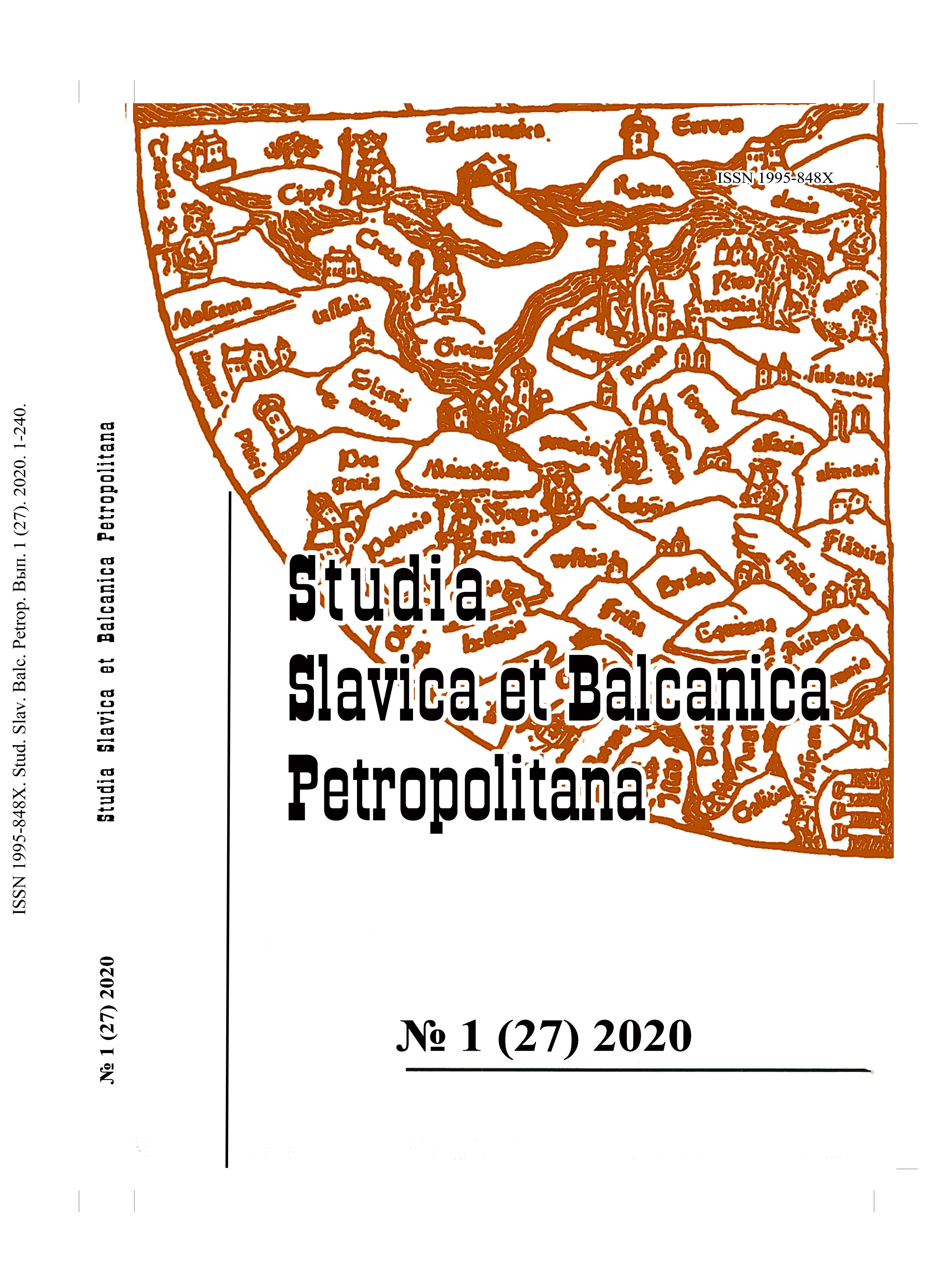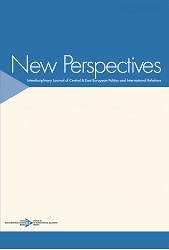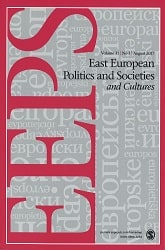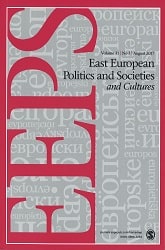
We kindly inform you that, as long as the subject affiliation of our 300.000+ articles is in progress, you might get unsufficient or no results on your third level or second level search. In this case, please broaden your search criteria.


The collapse of the Soviet Union in 1991 became the key historical event of the end of the XX century. The study of measures taken by the Soviet leadership to rescue the «last empire» and Ukraine's participation in disintegration processes form the basis of this article. The author reviewes the steps of the official Kyiv in order to achieve a real state separation with the Union Center after the proclamation of Ukraine's independence. Political maneuvers of the state leaders of the USSR and Russia in order to preserve any form of geopolitical construction under the name «USSR» are traced. The attitude of different groups of the Ukrainian political elite concerning the problem of the transformation of the USSR and the prospects of Ukraine's development as an independent state are analyzed as well as the role of the democratic parliamentary bloc – the People's Council in the process of sovereignty. The essence of the contradictions in the views of two parts of the Ukrainian establishment regarding Ukraine's participation in Kremlin political projects is revealed. The preconditions and the essence of the formation of political consensus between the part of the communist elite and nationally oriented opposition concerning the future status of the republic as an independent state are highlighted. The motives of the compromise solution of the Ukrainian government concerning the accession of the republic to the economic intergovernmental entity - Economic Community. The author presented his own interpretation of the role and significance of Ukraine in blocking of the «Novogorovsky process», after the final collapse of which the Soviet Union ceased to exist.
More...
The article evaluates the experience of nation-building in the case of ideological activity of Social and Cultural Association “Polisse”. The author analyses causes of its appearance, the tools used by its creators and the potential of the ethno-political myth they produced. The myth created by “Polisse” was a comprehensive and theoretically elaborated concept, which radically contradicted the previously adopted mythological narratives. Despite a wide range of ideas and rich argumentation, the myth failed to become a part of local identity, since it was rejected by the population of the region.
More...
The article is devoted to the formation of Albanian state in 1908-1912. The role of Great Powers is also analyzed in the article. Research is based on unpublished documents from Russian archives.
More...
Starting from the failed attempt by Professor Eugen Ehrlich, known today as the founder of the Sociology of Law as a research field and academic subject, to regain after World War I his professorship at the University of Chernivtsi, “re-founded” in 1919 as a Romanian university after the union with the Kingdom of Romania, we examine one of his few studies on political science, written and published in Bucharest in Romanian in the years 1920-1921 – a lucid analysis of the causes that led to the fall of the Habsburg Monarchy.Starting from the failed attempt by Professor Eugen Ehrlich, known today as the founder of the Sociology of Law as a research field and academic subject, to regain after World War I his professorship at the University of Chernivtsi, “re-founded” in 1919 as a Romanian university after the union with the Kingdom of Romania, we examine one of his few studies on political science, written and published in Bucharest in Romanian in the years 1920-1921 – a lucid analysis of the causes that led to the fall of the Habsburg Monarchy.
More...
The essay presents a personal approach to Bruno Schulz not only as an outstanding writer and artist, but above all as a figure of imagination that connects the worlds and cultures of Poles, Ukrainians, and Jews. The author defines this function as “worldbuilding” and places it in a process of reconstructing the semantic landscape of Galicia, devastated by World War II and mass deportations, which turned the postwar generations into semantic orphans. This reconstruction does not consist in the impossible return of Poles, Jews, and Ukrainians to Drogobych or Lviv, but in acknowledging the complex past of the region which is our home. Its picture stems from the text of the architectural heritage as well as written texts. Such a text or archetypal metatext has been the work of Bruno Schulz and many others, born in the same area: Joseph Roth, Leopold Sacher-Masoch, Paul Celan, Stanisław Lem, Zbigniew Herbert, Rosa Ausländer, Gregor von Rezzori, Manès Sperber, Georg Drozdowski or Bogdan-Igor Antonych. The task of reconstructing the Regions of Great Heresy has been performed not just in Drogobych, but all over our part of the world – in Lviv, Vilnius, Gdańsk, Wrocław, and Tschernivtsi. We have been trying to heal the wounds inflicted by World War II, which will take long, is by no means simple, and meets much resistance. Like in Schulz’s stories, we have embarked on a long but interesting journey and much is still to be discovered.
More...
The discussion, devoted to the consideration of the papers of Alexander Filyushkin and Alexey Martyniuk, took part at the special section of the Petersburg Historical Forum. The participants are from Russia, Austria, Slovakia, Estonia, Germany etc. Participants in the discussion highlighted the problematic points in the study of the history of the Eastern European region: the difficulty of defining the geographical and chronological framework, the problems of an established terminology, the break in the historiographic tradition, the need to search for new methodological tools and, at the same time, to verify the correctness of its application. Arguments were expressed both “for” and “against” the proposed thesis of Alexey Martyniuk about the “Byzantinization” of the history of Old Rus’. Most of the speakers spoke in favor of overcoming the situation of “national fragmentation” of the medieval history of Eastern Europe. The development of that research perspective that would allow us to see the history of this region as the history of a single space, which has its own dynamics, its own “rhythms” and its own characteristics, which are not reducible only to the common history of modern states and nations. The importance of comparative studies was emphasized — the need, when considering the history of Old Rus’ and the Eastern Slavs in the Middle Ages and Early Modern Times, to refer to the experience of studying the history of the southern and western Slavs, Byzantium and the medieval Balkans, the regions of the Baltic and Black Seas and, in the end, not to be afraid the search for typological parallels in “distant lands and eras” — in the history of Antiquity, the medieval Latin world, classical Western European Modernity. The discussion showed the importance of historians’ reflection on the subject and method of their research, as well as the need for constant professional dialogue between representatives of different national schools and historiographic traditions.
More...
Based on published and unpublished works of Ivan Petrovich Liprandi (1790–1880), this article considers evolution of the images of Serbs and Serbia in the period 1830–1860. Liprandi was studying the Ottoman Empire and the Balkans for 50 years and he was recognized by contemporaries as one of the foremost experts on the history and culture of the European regions of the Ottoman Empire. During the 1830-1860s his views underwent significant changes, and Liprandi went from an executive officer, collecting ‘objective’ information about the southern Slavs, to a staunch supporter of imperial pan-Slavism. In the 1830s Ivan Petrovich can be described as a representative of ‘practical’ Slavic studies. Being in the south of Russia, he was gathering information on the peoples of the Balkan Peninsula for his superiors. Based on the Enlightenment paradigm, Liprandi was convinced that independent Serbia should become a conductor of Russian influence in the Balkans. In turn, the empire would help the Serbs get rid of the ‘remnants’ of Ottoman rule and join the family of enlightened nations. However, by the middle of 19th it had become obvious that Serbia preferred to be Western-oriented in its foreign policy. At the same time, Liprandi became to be in close to supporters of imperial pan-Slavism (A.F. Veltman). As a result, Ivan Petrovich’s views on the Serbs underwent significant changes in the second half of the 19th century. He departed from the rhetoric of the Enlightenment and wrote about the Serbs as a nation who had lost the best features of the Slavs. Liprandi orientalised the Serbs and attributed to them all the negative qualities that previously attributed only to the Turks. As a result, in the works of Liprandi in the 1860s in descriptions of Serbs, extremely negative connotations prevailed and Serbia was portrayed as an unsuccessful example of modernization, as a result of which people lost their best qualities but could not fully join the achievements of European civilization.
More...
Considering the differences between the superficial orderliness of the English/British table of royal succession and the apparent anarchy of its Bohemian counterpart, this essay questions aspects of the analysis of English state formation offered in Philip Corrigan and Derek Sayer’s 1985 study The Great Arch: English State Formation as Cultural Revolution. Rather than providing a contrast to England’s institutional political continuities over centuries, Bohemia’s manifestly fractured history furnishes a vantage point from which the ideological character of such claimed historical continuities becomes clear. E. P. Thompson’s image of a “great arch” of state formation attributes far too much shape, solidity, and coherence to a process that was always, whether in England or Bohemia, a matter of flux and fluidity – a landscape in constant erosion, upon which coherence is only ever imposed in momentary retrospect.
More...
The manuscript analyzes negative developments in Bulgarian and Romanian politics in the aftermath of the two countries’ accession to the European Union, with a special focus on the worsening corruption problem, the destabilization of previously coherent normative frameworks, and the reversal of processes of state building. It also explores the main characteristics of a novel form of elite behavior, post-accession hooliganism, which began to emerge as soon as Bulgarian and Romanian political leaders felt strong and confident enough to disregard the demands of their West European counterparts.
More...
The dramatic changes of 1989 have been widely understood as the confirmation of Western, liberal democracy as the ultimate model of the modern polity. The fact that 1989 was about a dual language that not only emphasized the rule of law and the implementation of rights, but also articulated ideas of democracy alternative to the mainstream liberal-constitutional idea, has not been at the forefront of interpretations of post-1989 trajectories. This does not mean, though, that 1989 has not had implications for the democratic imaginary and structures emerging in the new democracies. Dissidence has had important even if less visible implications for democratic imaginary and structure in ways that are still being played out. It should be recognized that the events of 1989 and dissident thought also indicated alternative, republican democratic models that have had implications for the democratic structures emerging in the wake of 1989. In the contribution, the author will first briefly discuss the one-sidedness of interpretations of democracy in post-1989 Central and Eastern Europe and, subsequently, highlight one alternative understanding of democracy that has emerged in some of the dissidents’ ideas prior to and in 1989, in particular in terms of notions of republican democracy. Second, the author will discuss some instances—predominantly referring to the experiences in the Czech Republic, Hungary, and Poland—in which the influence of dissident ideas on constitutional and legal-institutional transformations, in particular regarding local self-government and direct democracy, becomes visible.
More...
In the twentieth century, nationalism has become an unwritten yet strong hegemonic rule that prescribes and defines cultural configurations of statehood. In the context of post-socialist and post-colonial transformations in “expanding” Eastern Europe, nation building is a complicated and incoherent process: the nation’s canonic attributes may contradict the cultural and historical “circumstances” of the development of a particular nation. This article questions a complicated dynamic between theoretical frameworks of nationalism and their applications in Eastern European states, such as in Belarus. More specifically, it argues against the discursive conceptualization of Belarus as a “nonexistent” or “undeveloped” nation. This article suggests rethinking nation building in Belarus in relation to the notion of major/minor developed by Deleuze and Guattari. The author implies that the unusual mode of Belarusian nationalism is not only a part of a struggle for domination between different intellectual groups in Belarus; it is also an issue of relying on traditional scholarly paradigms of nationalism that may no longer suffice.
More...
Nearly two decades after renewed independence, the population of Latvia is quite unhappy with the status quo. The number of inhabitants in the country continues to decline due to outmigration and a low fertility level; the international image of the country is believed by Latvians to be ambiguous at best, negative at worst; there is widespread disillusionment with the new political elite, which is thought to be incompetent as well as corrupt; the market economy has not produced straight-line economic progress but rather a growing subpopulation living at the minimal standard of living; continuing divisions of opinion over a wide range of subjects (such as the meaning of World War II and the question of the country’s official language) continue to suggest at least incomplete social integration; and the openness brought by the instruments of the information revolution appears to many to contribute to dissension and not cohesion. This was not the normality Latvians had aspired to during the heady years of unified opposition to Soviet power in the 1988–91 period, but the characteristics of this normality are shared in different combinations by many members of the European Union.
More...
Central and Eastern Europe, a periphery of the advanced western half of the continent experienced severe crises of failed or sputtering modernization attempts during the nineteenth and twentieth centuries. The agricultural and rural economy of the peasantry was preserved in this area until the mid-twentieth century. Relatively backward, the partially industrialized countries of the region could not respond positively to the challenge of repeated technological-industrial revolutions and structural crises in the late nineteenth century, and again in the interwar decades. They were unable to adjust to the requirements of the third and fourth technological-industrial revolutions of those periods. [...]
More...
The Declarations of 16 February 1918 and of 11 March 1990 have much in common. Both declarations of independence were made under conditions of occupation. Foreign powers holding Lithuania under their rule-in the first instance Germany, in the second the Soviet Unionwere playing an intricate game with its society. Initially, Sajudis and its leadership, like the Council of Lithuania in 1918, were acting with the connivance and even with a kind of approval of the occupying authorities. Pursuing their own goals, far from identical with the Lithuanian interest, neither occupying power objected to a limited Lithuanian selfrule, but were strictly opposed to any aspirations for full independence of the country. In both cases, the liberation process quickly slipped out of their control. Lithuania, whose leaders were better able to anticipate the course of events than their adversaries and who succeeded in aptly exploiting the inner divisions and weaknesses of the regime, won the game. [...]
More...

In this paper, the contribution of the Faculty of Law of Kazan University to the development of the TASSR statehood was studied. Three major groups of events and persons were singled out based on the degree of their influence: lecturers and researchers, who worked at the Faculty of Law in different years (Faculty of Social Sciences, Law Institute); state and public figures; law enforcement and court officers. The transformation of the Faculty of Law in line with the reforms in the higher education system of the USSR was considered. Special attention was paid to the role of the Faculty of Law in the development of cities and infrastructure of the TASSR, as well as in ensuring the rule of law during the administration of justice. Through the prism of outstanding personalities of the Faculty of Law, the history of Tatarstan during the Soviet period was constructed.
More...
The development of the Tatar Autonomous Soviet Socialist Republic (TASSR) was studied. Factors that influenced its form and territorial structure were analyzed. Special attention was paid to the concept of Soviet autonomy as a way of legitimation of the national statehood of the Tatar people. The evolution of this concept was traced with regard to its relation to the principle of federalism. The conditions under which the conceptual and organizational confrontation of two opposing trends – weakening and strengthening the legal status of the Tatar Republic – were explored. The views of persons involved in this process were discussed. Problems of the legal status of the Tatar Republic were considered from the perspective of general trends in the development of autonomous republics within the RSFSR, as well as taking into account all regional features characteristic for the formation of the Tatar Republic. The influence of the creation of the USSR on the possibilities of improving the national statehood was assessed. The reasons that slowed down the constitutional development of the region were revealed. The factors that prevented the first Constitution of Tatarstan of 1926 to come into force due to its nonrecognition at the federal level were covered. The idea about subordination of the legal norms and officially declared principles to the political expediency and subjectivism was substantiated.
More...
In this article the role of Besim Atalay’s work “Turkish Elders or Turkish Surnames” in the Surname Law practices of Turkish Republic will be discussed. Atalay, the author of the work was among the Ottoman intellectuals of the last period, and he was in Turkism movement. In the 1910-1920 period, he worked as a teacher and director of education, entered the first Grand National Assembly of Turkey in April 1920, and served as a deputy until 1946. Within this process, it is seen that Atalay showed a full devotion to Atatürk and his reforms and actively involved in the simplification movement of Turkish language especially with his studies on language. He also had an important role in surname law practices, which can be evaluated within the project of Westernizing new Republic’s Turkish society. This practice which aims to conform to the Western world, had a strong relation with nationalist ideology since it encouraged Turkish surnames to be taken. At this point, Atalay’s book, which was published firstly by the Turkish Grand National Assembly in 1923, was published again by the state in 1935 and 1936, and also upon the order of the Ministry of Internal Affairs the names in this book were came out as a list in all newspapers across the country. It is also noteworthy that there were some other publications, which imitated his book to a large extent. Apart from these, it is interesting that Atalay made some important ideological changes in his book. Many words such as sultanate and sultan were completely removed from his text and by doing so his book was adapted to a new political environment.
More...
The author aims to capture the significance of the celebration of Nauryz, the ancient celebration of spring, family, and local community. She describes various forms of celebrating Nauryz on the official, national, local, and family level in Kazakhstan. She emphasizes that the renewed tradition of celebrating Nauryz is part of a process deliberately adopted by the Kazakh authorities in the post-Soviet period in order to build a community from a state of many ethnicities. She states that all the ways of celebrating Nauryz appeal to the original motivation of sustaining, restoring, and strengthening the community. This leads to the formation of communitas (in Victor Turner’s sense), which is conducive to forming the inhabitants of modern Kazakhstan into a multi-ethnic community.
More...